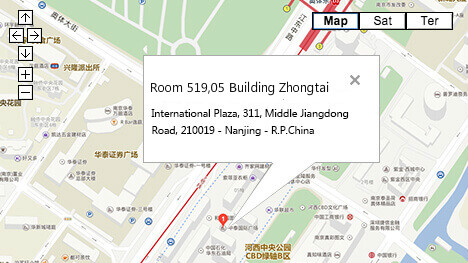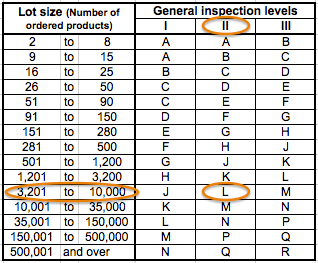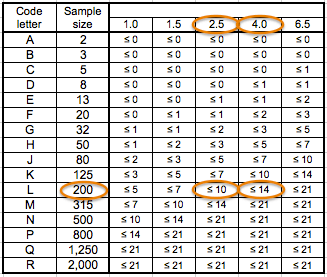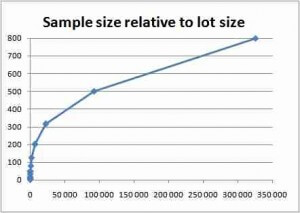Pins recall alert published by the United States Consumer Product Safety Commission ( CPSC) and…
What is the “AQL” (Acceptance Quality Limit) in simple terms?
BY RENAUD ANJORAN
‘AQL’ stands for ‘Acceptance Quality Limit’, and is defined as the “quality level that is the worst tolerable” in ISO 2859-1. It represents the maximum number of defective units, beyond which a batch is rejected. Importers usually set different AQLs for critical, major, and minor defects. Most Asian exporters are familiar with this type of setting.
For example: “I want no more than 1.5% defective items in the whole order quantity, on average over several production runs with that supplier” means the AQL is 1.5%.
The “AQL Tables”
The “AQL tables” are statistical tools at the disposal of buyers (for product inspections). They are an industry standard. Most suppliers involved in international trade are familiar with it.
They help determine two key elements:
- How many samples should be picked and inspected, among a batch of product or parts?
- Where is the limit between acceptability and refusal, when it comes to defective products?
(If you’d like to see how to use AQL tables, scroll down to the section “Getting familiar with the AQL tables” below.)
The need for an objective measurement of quality
In certain product categories, there will be defective products in virtually every production batch. It is often true even after the manufacturer has checked each individual product and has repaired the defective ones, since visual inspection is not 100% reliable.
Therefore, in many supplier/buyer relationships (particularly when the application does not result in life or death outcomes), the supplier is not expected to deliver defect-free goods. The buyer needs to control the quality of purchased goods, since he does not want too many defects. But what does “too many” mean?
How to set the limit between acceptability and refusal in a way that can be agreed upon and measured? This is what the AQL comes into play.
What is the AQL?
As I wrote above, the ‘AQL’ is the “quality level that is the worst tolerable” on average over a period covering a number of batches.
In practice, three types of defects are often distinguished. For most consumer goods, the limits are:
- 0% for critical defects (totally unacceptable: a user might get harmed, or regulations are not respected).
- 2.5% for major defects (these products would usually not be considered acceptable by the end user).
- 4.0% for minor defects (there is some departure from specifications, but most users would not mind it).
These proportions vary in function of the product and its market. Components used in building an airplane are subject to much lower AQL limits.
Note that this tool is used mostly during final outgoing inspections (when the products are ready to be shipped out), and sometimes during production (when the number of products is sufficient to have an idea of the batch’s average quality).
Getting familiar with the “AQL tables”, sometimes called “ANSI tables”
Before using the AQL tables, you should know three parameters:
- The ‘lot size’. If you ordered different products, consider each product as a separate lot. (The quantity of each product is the lot size). If you ordered only one product, the lot size is the total batch quantity.
- The inspection level. Different inspection levels will command different numbers of samples to inspect. In this article, we will stick to the so-called “level II” under “normal severity” and to single sampling plans.
- The AQL limits appropriate for your market. If your customers accept very few defects, you might want to set a lower AQL for both major and minor defects.
Some specialized quality inspection software will show all the numbers automatically, but it is good to understand how to read the tables.
There are basically two tables. The first one tells you which ‘code letter’ to use. Then, the code letter will give you the sample size and the maximum numbers of defects that can be accepted.
First table: sample size code letters
How to read this table?
If you follow my example, I assume your ‘lot size’ is comprised between 3,201 pcs and 10,000 pcs, and that your inspection level is ‘II’. Consequently, the code letter is “L”.
Second table: single sampling plans for level II inspection (normal severity)
How to read this table?
Your code letter is “L”, so you will have to draw 200 pcs randomly from the total lot size.
Besides, I assume you have set your AQL at 2.5% for major defects and 4.0% for minor defects. Therefore, here are the limits: the products are accepted if NO MORE than 10 products with major defects AND NO MORE than 14 products with minor defects are found.
For example, if you find 15 products with major defects and 12 products with minor defects, the products are refused. If you find 3 with major defects and 7 with minor defects, they are accepted.
Note: in quality inspections, the number of defective products is only one of the criteria. It is sometimes called “quality”, or “quality findings”. The other criteria are usually on the inspector’s checklist, which typically includes:
- Packaging conformity (barcodes, inner packing, cartons, shipping marks…).
- Product conformity (aspect, workmanship…). If all the products are in red color instead of orange, there is no need to count each sample as a defect. It makes more sense to refuse for product conformity.
- Specific tests defined in the inspection checklist (they might not be performed on all inspected samples if they are time-consuming or destructive).
Special case: the AQL in the Codex standard stan233
There is another widely-used standard for food products. It calls for taking a much smaller sample (which make sense since opening a food product’s packaging means destroying it).
The general approach is the same, from what I saw, with some differences (e.g. the tables are different depending on the net weight of a unit of product).
Frequently Asked Questions about AQL
Q: So, basically I have to authorize the factory to produce some defects?
A: In theory no. That’s why the AQL was renamed, from “acceptable quality level” to “acceptance quality limit”. It is a “limit” (and a loose one at that).
Here is what the ISO 2859 standard says:
“Although individual lots with quality as bad as the acceptance quality limit may be accepted with fairly high probability, the designation of an acceptance quality limit does not suggest that this is a desirable quality level. Sampling schemes […] are designed to encourage suppliers to have process averages consistently better than the AQL.”
Note that, in practice, using these statistics means you assume the factory cannot reasonably be expected to turn out 100% good quality.
Alternatively, you can choose an “acceptance on zero” plan. As soon as one defect is found, the inspection is failed. But you can impose this to suppliers only in situations where quality requirements are very high (in the auto industry, in aerospace…).
Q: As a buyer, should I charge back the value of the defective products to the manufacturer?
This is not standard practice. The standard practice is actually to charge nothing back, as long as the inspection is passed.
However, as the buyer, make sure to add this provision in your contract with the supplier: if an inspection is failed, the supplier has to sort & rework the goods, and submit them to a new inspection (and the re-inspection costs are charged back to them).
Q: Based on my AQL, I calculated the proportion of defects authorized. Why don’t they correspond to the maximum number of defects authorized?
A: It is true. In our example above, 2.5% of 200 samples is 5 samples, but we accept the goods even if 10 samples are found with a major defect.
Why this difference? There are heavy statistics behind this issue. To keep it simple, the producer’s risk is his risk of rejection (based on the random element when drawing the sample) even though his products (if they were all checked) would be accepted. That risk is about 5% in this standard. And, along the same logic, there is a consumer’s risk and is is around 10%. As you can see, this standard is favorable to the producer’s side.
Q: Why not just say, ‘we’ll check 10% of the quantity’, or whatever percentage deemed appropriate?
A: this is discouraged, as clause 4.3.3 of the ISO 2859-10 standard explains:
Ad hoc sampling should not be used because it will lead to unknown risks that may be too high. Furthermore, there is no formal basis for either the acceptance or non-acceptance of the lot. Examples of ad hoc sampling include sampling of a fixed percentage of a lot or a convenience sample taken at haphazard times.
And here is one thing many buyers don’t realize. They say “inspect 10%”. But, as we go up in the total quantity, the proportion of products checked can decrease, for the same confidence in the inspection results.
As you can see in the chart below, if you follow the AQL tables, the number of samples to check (vertical axis) increases at a slower pace than the total quantity (horizontal axis).
Q: How to choose an AQL limit for my products?
A: I explained it in details in this article. It depends on your distribution channel and your product’s end use. Note that your supplier might refuse AQL limits they estimate as too tight (i.e. too low).
Q: Do we have to follow levels I, II, III, etc. and AQLs 1.0, 1.5, 2.5, etc.?
No. They are mere parameters that were thought to be applicable to most situations. For the sake of simplicity, it is better to have 3 tables with 10-20 columns each, than 50 tables with 100 columns each. Remember, all this was computed by hand in the 1930s, and inspectors had to look up the tables in paper form.
If you have a statistical software package such as Minitab, you can adjust the parameters as you see fit.
Q: What are the “reduced” and “tightened” severities?
A: They are designed to be used in very specific situations, when a producer is particularly reliable, or on the contrary fails too often.
In practice, these severities are seldom used. Most inspections are done in normal severity. The rules to switch from normal to reduced or tightened are considered an important part of the standard (actually the evolutions of these rules constituted the main changes from MIL-STD 105A and MIL-STD 105E) but can be ignored.
Jim Bossert wrote this in the Feb. 2016 issue of Quality Progress:
You can use any plan without using the switching rules, but you do run the risk of not meeting the alpha risk in the end. These plans were developed to be used, as documented.
A normal plan is generally used and the switching rules come in when the clearance number has been obtained.
Some processes may never switch. If you choose a plan that is tightened or reduced to start with, you potentially will either spend too much on inspection (tightened) or risk having a bad product go to the customer (reduced).
It is a business decision for you to make if your customer is not demanding it. The switching rules are there to protect the producer when the product is running well or it has problems.
Q: What are the limits of a quality control approach based on random sampling and AQL limits?
A: There are several limits:
1. An AQL limit is a target rather than a maximum. The buyer might have a nasty surprise when receiving a batch of products that “passed” the inspection.
2. A statistical QC approach does nothing to reduce the defects in the first place.
Q: Can’t I just do my own sampling plan?
Sure. If you have a math background, you know that you’ll need to use a hypergeometric distribution (since samples are taken from the lot at random, are checked, and not put back into the lot until the end of the inspection). Specialized software like Minitab can help you a lot here.
If you want to avoid statistics altogether, your limits on the numbers of defects will not make much sense, but they might “feel” right intuitively and it might make you more comfortable… Just be aware of their shortcomings.
Make sure you get the supplier’s agreement on your plan. This might be the hardest thing to achieve!
Q: Is there a more efficient way of checking quality of finished products?
There are many ways of drawing samples and checking their quality.
If you don’t mind a more dynamic inspection plan, where the number of samples to check can’t be predicted in advance, you might want to follow a multiple-sampling plan, or even a sequential sampling plan. On average, for the same confidence in the decision, fewer samples will need to be checked.
Q: Where can I learn more about the AQL?
If you really want to understand the concept of the AQL, you should spend about 20 minutes (total) watching these 3 videos on Youtube.
Article Source: https://qualityinspection.org/what-is-the-aql/





This Post Has 0 Comments